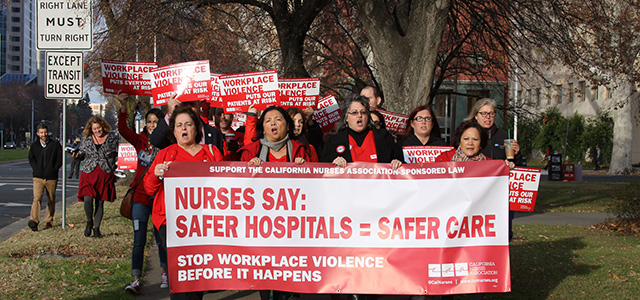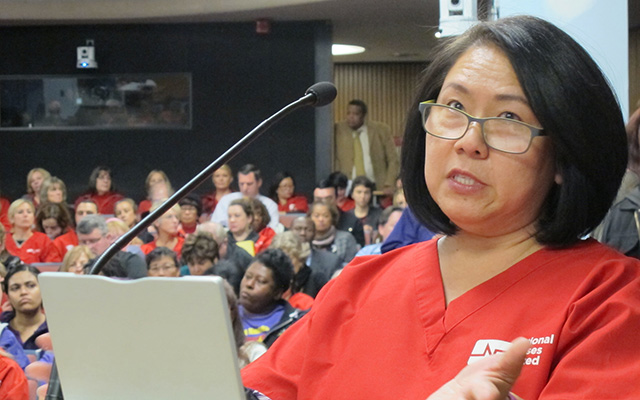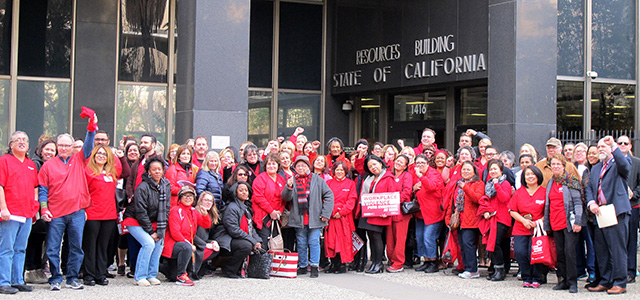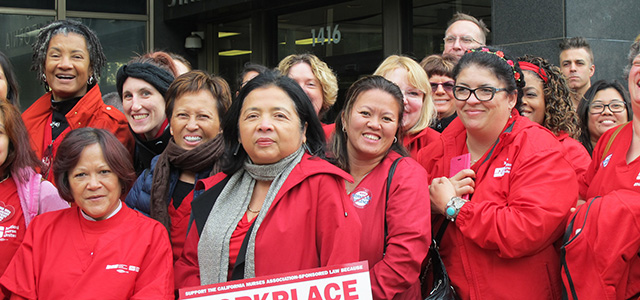Blog
Nurses Speak Out at Cal/OSHA Public Hearing: Urge Speedy Passage of Violence Prevention Regulations

A large contingent of nurses from throughout California, clad in red scrubs, marched through the Capital mall in Sacramento yesterday chanting “Workplace violence on the rise, prevention is our key to survive!” as they made their way to the Cal/OSHA public hearing on workplace violence. After they arrived at the State Resources Building, the nurses, members of the California Nurses Association/National Nurses United, filled the hearing chambers and lined up at the podium to urge that the Cal/OSHA's Standards Board swiftly adopt the proposed regulations on workplace violence prevention.
The regulations will implement SB 1299, the Workplace Violence Prevention Act, which was authored by former State Senator and current Secretary of State, Alex Padilla, sponsored by CNA/NNU and signed into law by Gov. Jerry Brown last year.
“We are in the midst of an epidemic of violence against nurses,” said RN Bonnie Castillo, CNA/NNU Associate Director, speaking on behalf of over 90,000 registered nurses represented by CNA.

Ching Cheah, an RN at St. Jude Hospital in Fullerton, CA testifies at yesterday's Cal/OSHA hearing.
“All the nurses in this room either know someone or have themselves experienced physical violence, threats and assaults on the job. They all experience the fear and frustration of knowing that the procedures their employers have in place are not enough to prevent violent acts from occurring, or to respond adequately when they do. As nurses and health care workers, we are in danger, and we simply cannot wait any longer for the protections we deserve.”
"It is long past time to hold employers in the healthcare industry accountable for preventing and mitigating the risk of workplace violence. We support the proposed regulations because they implement and build upon the strong protections we fought so hard for in SB 1299. We urge speedy passage of the regulations so that we can have comprehensive workplace violence plans in place as soon as possible. Every day we wait is a day that workers are at risk of physical violence, psychological harm, and even death," said Castillo, who is also the Director of RNRN, the Registered Nurse Response Network, a project of NNU.
CNA board member Katy Roemer, an RN at Kaiser Oakland’s Maternity unit, commended the regulations for covering "healthcare workers in all facilities, outpatient medical offices and clinics, home health care and home-based hospice, paramedic and emergency medical services, field operations, drug treatment programs, off-site operations, and ancillary health care operations such as school nursing and retail clinics.”
Roemer also expressed nurses’ appreciation for Cal/OSHA’s proposing a broad definition of workplace violence, “that incorporates actual acts of violence as well as the threat of violence or use of a dangerous weapon, regardless of whether the employee sustains an injury...The threat of physical force or use of a dangerous weapon can have very real and lasting impacts, such as psychological trauma and stress.”

Nurses came from throughout California to participate in the Cal/OSHA hearing, from as far away as San Diego, and many places in between, including, Irvine, Mission Viejo, Fullerton, Long Beach, San Bernardino, Los Angeles, Modesto, Stockton, Watsonville, Salinas, San Jose, San Francisco, Oakland, Sacramento and Roseville.
In her comments, Malinda Markowitz, CNA co-president and RN at Good Samaritan Hospital in San Jose, noted the trend in several states to try to address workplace violence solely by criminalizing the perpetrators, who are for the most part, patients and their loved ones. Nurses support the proposed regulations because they “emphasize prevention over criminalization,” she said. “As nurses, we know that the perpetrators are often suffering from mental instability, addiction, side-effects from medications, or other conditions outside their control. We are patient advocates, and we do not believe that locking up more mentally ill patients is the answer.”
RN Seyma Anajafi, who works at Long Beach Memorial Medical Center, supports the proposed regulations that require "involvement of employees like myself at all stages in developing the workplace violence prevention plan. Without our input, it is likely that many crucial risks and realities would be overlooked for the sake of the employer’s convenience and ease. Requiring input from employees ensures that no risk goes overlooked and that the true experts are consulted in the development of the plan,” said Anajafi.
Noting the packed hearing room, Cal/OSHA Standards Board Chairman David Thomas, said, “It is very moving and astounding to me to have 250 nurses in the hearing room who have all experienced some kind of workplace violence. That is how important these regulations are to protect workers.”
Boardmember, David Harrison, who is also with Operating Engineers Local 3, thanked the nurses for their participation in the regulatory process. “This is the point of having a union and union representation. It is very important to have your voice heard,” he said.

While the overwhelming majority expressed enthusiastic support for Cal/OHSA’s proposed regulations, a spokesperson for the industry lobbying group, the California Hospital Association, argued that "violence can happen anywhere," and while it can happen in a hospital it isn’t “inherent” to hospitals so it is not something that employers should have to take responsibility for.
“When the hospital industry argues that we need to accept the possibility of violence happening in a hospital and advocates that they not be held accountable for providing a safe therapeutic environment, they are essentially saying they don’t want to do their job,” said Castillo.
"It was pathetic to see the hospital industry spokesperson try to water down the regulations but Cal/OSHA really heard us," said Ching Cheah, an RN at St. Jude Hospital in Fullerton. "It gave me a strong sense of power to know that CNA/NNU represents us well in legislative and regulatory areas against the hospital industry."
Today’s public hearing marked the final day of a 45-day public comment period on the proposed regulations related to SB1299. Cal/OSHA will review all the comments and issue the next version of the proposed regulations early next year. The regulations must be finalized and implemented by June 2016.
CNA/NNU sponsorship of SB 1299 and advocacy on behalf of strong violence prevention is a model for the nation. Other National Nurses United affiliates, including the Massachusetts Nurses Association and NNU members in Washington DC are campaigning for similar legislation in response to workplace violence as a serious occupational hazard for RNs and other health care workers.
Here's a social media wrap up of yesterday's activities: https://storify.com/nationalnurses/sacramento-hearing-on-workplaceviolence-prevention
To see photos of yesterday: https://www.flickr.com/photos/californianurses/albums/72157660174452054
Here is an overview of California's proposed workplace violence prevention regulations.
All healthcare settings must develop a prevention plan that includes:
- Procedures to identify environmental and patient-specific risk-factors,
- Procedures to correct workplace violence hazards, including engineering and work practice controls such as implementing adequate staffing, removal of sight and communication barriers, provision of surveillance systems, use of a buddy system, reconfiguration of facility spaces, removal or securing of objects that may be used as improvised weapons, installation of alarm systems, and other effective means,
- Procedures for post-incident response and investigation, including providing individual trauma counseling to all employees affected by the incident,
- Employee involvement in the development, implementation, and review of the plan.
The regulations require employers to provide an initial training for all employees, which emphasizes preventative measures such as how to recognize the potential for violence, how to counteract factors that lead to the escalation of violence, how to seek assistance to prevent or respond to violence, and strategies to avoid physical harm. The regulations also require the employer to conduct an annual review of the Workplace Violence Prevention Plan and to correct any problems that are uncovered.